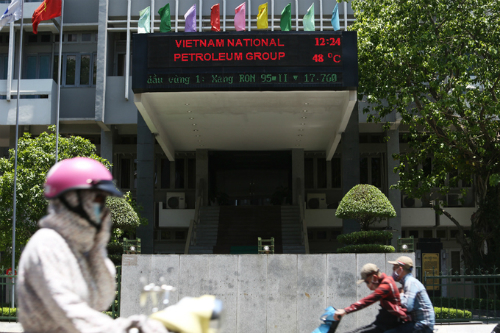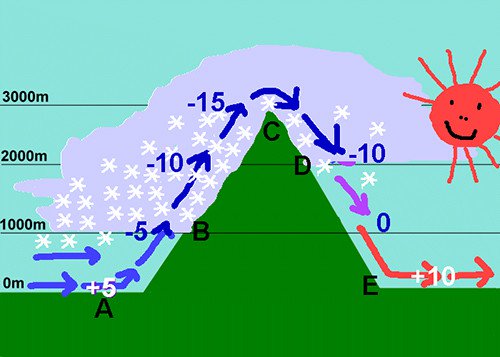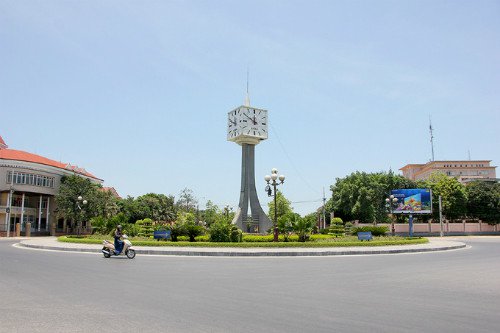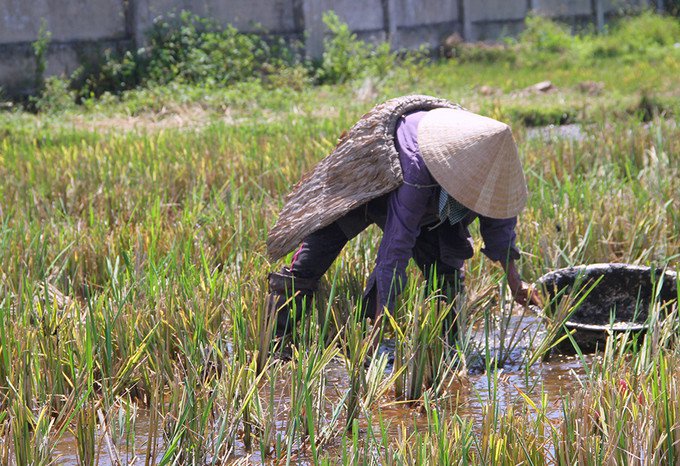Distinguish hot sun concepts
Hanoi is experiencing intense hot days, the highest temperature is 42 degrees Celsius. Many people just feel, or hear the reporters notice, not understand the related concepts.
- What is El Nino, why does it have such a name?
- 5 ways to cool the roof in extremely hot and sunny days
How is the weather called hot sunshine?
Hot weather is a special type of weather that usually occurs during the summer months. One day, in a locality, it is considered to be hot weather when the highest temperature (symbolized Tx) reaches 35 degrees C
In a forecasted area (eg Northern Delta), if at least half of the monitoring stations are observed, the highest temperature in Tx ≥ 35 degrees C is called a hot day. widespread. When only observing less than half of the stations in the region with the highest temperature in Tx ≥ 35 degrees C, it is called the local heat.
One day is considered to be a fierce heat on a large scale when at least 2/3 of the monitoring stations in the region have the highest temperature Tx ≥ 35 degrees C, of which at least half of the monitoring stations in the region forecast the highest temperature Tx ≥ 37 degrees C.
When wide-area sunshine appears continuously for 2 days or more in a forecasted area, it is called a heat wave.

In hot sunny days, the outdoor temperature is usually 4-6 degrees higher than the temperature measured in meteorological stations. (Photo: Ngoc Thanh).
What is the slippery effect (or hot dry wind)?
In meteorology, the phenomenon of wind passing the mountain is called foehn. From the side of the mountain to receive the wind, the air moves up, the higher the air, the more cold it becomes and the agglomeration creates clouds for the rain on the side to receive the wind, and to collect more heat from the condensation emitted.

Mechanism to form wind.(Photo: National Hydrometeorological Center).
After crossing the mountain pass, the wind blew down this mountain. At that time, the air has become drier, the temperature has increased due to the air being compressed, so to the foot of this mountain side the air becomes hotter and hotter than the air on the side of the wind.
This phenomenon is called phlegm and hyperthermia, moisture effect is called a lisp effect. The stronger the effect, the more air the air reaches to the side, the more humid the wind and the higher the mountain peak. For example, with a mountain range of 3,000m, the air temperature across the mountain is 10 degrees Celsius, to the foot of this mountain side the temperature is up to 18 degrees C.
What is Lao wind?
Every year, in the summer months, Central Vietnam is often influenced by the summer monsoon winds blowing from the Bay of Bengan in the southwest direction. After crossing the territory of Cambodia and Laos, the wind has lost some moisture, encountered the Truong Son Mountain Range, the air has been pushed up high and cold, so most of the condensed water vapor has formed rain and falls down. west side of Truong Son range. When blowing to the east side, the wind becomes dry and hot. People often call this wind Lao wind. Thus, the Lao wind is also a hot dry wind due to the phlegm effect.

Vinh City, Nghe An, where often affected by Laos wind.(Photo: Nguyen Hai).
The main driving force behind the Lao wind is the low pressure area usually formed in China and China, sometimes the low pressure center is located in the North Delta. The low pressure area has the effect of drawing wind through the Truong Son range. The deeper this low pressure area (meaning that the lower the central pressure in the low pressure area), the stronger the wind blows, and there is a case spreading to the North, up to the Viet Bac area.
When do Lao winds appear?
Every year in the coastal provinces of Central Vietnam, the Lao wind season usually starts from April to mid-September, blowing the most in June and July. According to statistics, each month this average has 7 -10 days, of which 2-4 days the Lao wind blows strongly. Lao wind often blows in waves, short-term 2-3 days, 10-15 days long, lasting up to 20-21 days.
In one day, Lao wind often starts to blow from 8-9 am until evening, blowing the most from near noon to late afternoon, sometimes blowing continuously throughout the day and night, there is a 10-day-long night.

In order to cope with the burning Lao wind, farmers go to the fields to wear a shirt made of palm leaves.(Photo: Duc Hung).
When Laos winds blow, the highest temperature during the day often exceeds 37 degrees Celsius and the relative humidity of the day often drops very low, sometimes down to 30%. The sky was not cloudy, the sun was shining, the wind blew evenly like a fan of fire, the trees withered, the ponds dried up, the people and the animals were suffocating, it was easy to fire.
Other places also have hot dry winds, but the level is lighter than the Central. To quantify the phenomenon of hot and dry wind, meteorologists give the target: the day has a temperature> 35 degrees C, the relative humidity ≤ 55% is considered a hot and dry wind.
What is the sign of the Lao wind coming?
Before the phenomenon of Lao wind blowing, the sky is often blue, the wind is weak or calm. In the sky there are only a few tiny clouds. The western horizon often has orange-yellow dry blinds, a very clear atmosphere that can sense a hot thing makes the skin look like it is in a mild fever. It is a warning sign that there will be Lao wind after a short time.

The hot season is also the exam season so both parents and students struggle.(Photo: Giang Huy).
At the same time, if you watch the evolution of meteorological factors in the day, you will see the following:
- The wind changed direction, weakened, then turned counterclockwise, indicating a low pressure area was dominating.
- The pressure is continuously reduced, when the largest reduction is made, the Laos wind will blow the most.
- Very good foresight.
- Of course, to forecast the weather with Laos wind, it is necessary to rely on the evolution of the weather systems in the region.
According to VnExpress
You should read it
- Why go to the sun on everyone will be dizzy?
- What to do to get rid of the feeling of 'sunstroke' a third person?
- Today, the hot sun in Hanoi reached a record of 41 degrees Celsius
- The sundial does not use batteries, electricity or any motor
- 8 indications that the computer is infected with spyware
- Top 3 free apps to help avoid the most popular summer sunshine on smartphones
- Create sponge that can boil water
- Top 6 virtual reality games worth playing today
May be interested
- How to distinguish genuine and fake laptop chargers
 the tips below help you to distinguish the quality of a computer eye charger with an accuracy of about 60-70%.
the tips below help you to distinguish the quality of a computer eye charger with an accuracy of about 60-70%. - These are the 9 equations that changed the world, how many can you understand?
 mathematics is the study of concepts such as quantity, structure, change, and space. some groundbreaking mathematical concepts not only changed human history, but profoundly changed the world we live in!
mathematics is the study of concepts such as quantity, structure, change, and space. some groundbreaking mathematical concepts not only changed human history, but profoundly changed the world we live in! - Distinguish - The difference between Mbps and MBps
 distinguish - the difference between mbps and mbps. when you download or copy something, you will see parameters such as: mb / s, mb / s ... these are very common parameters used on computers but few people care and understand. get out of its meaning. probably h
distinguish - the difference between mbps and mbps. when you download or copy something, you will see parameters such as: mb / s, mb / s ... these are very common parameters used on computers but few people care and understand. get out of its meaning. probably h - Difference between Access Point and Router
 surely, you have heard many people talking about 'routers' and 'access point' devices. so are these two concepts referring to the same thing? the answer is of course no!
surely, you have heard many people talking about 'routers' and 'access point' devices. so are these two concepts referring to the same thing? the answer is of course no! - How to distinguish ethanol and methanol
 ethanol is usually less harmful to humans because it is produced by starches and cereals. meanwhile, methanol is an industrial solvent used to dissolve inorganic, organic ... and prepare other industrial chemicals.
ethanol is usually less harmful to humans because it is produced by starches and cereals. meanwhile, methanol is an industrial solvent used to dissolve inorganic, organic ... and prepare other industrial chemicals. - Can you distinguish hi-res audio?
 there was recently an online test to see if you can distinguish hi-res audio files from regular ones.
there was recently an online test to see if you can distinguish hi-res audio files from regular ones. - Apple shows users how to distinguish phishing emails from the App Store
 apple has just published a guide on how to distinguish fraudulent emails.
apple has just published a guide on how to distinguish fraudulent emails. - How to distinguish true white iPhone 4 - fake
 besides the original white iphone 4, the market has appeared products to change the shell to raise the price that the merchants or so called 'build'. experts gave some notes to distinguish true-fake.
besides the original white iphone 4, the market has appeared products to change the shell to raise the price that the merchants or so called 'build'. experts gave some notes to distinguish true-fake. - How to distinguish real iPhone X, fake company and Taiwan
 how to distinguish the real iphone x and what is fake (taiwanese goods). let's find out through the following article?
how to distinguish the real iphone x and what is fake (taiwanese goods). let's find out through the following article? - What is ECC RAM? Distinguish between ECC RAM and regular RAM
 let's learn what the concept of ecc ram is and distinguish between ecc ram and regular ram through the suggestions in the following article.
let's learn what the concept of ecc ram is and distinguish between ecc ram and regular ram through the suggestions in the following article.










 Not only people but even animals do not dare to array to the unique tree species on this planet
Not only people but even animals do not dare to array to the unique tree species on this planet Pests can eat plastic, savior of man-made plastic waste
Pests can eat plastic, savior of man-made plastic waste Top 11 exotic animals you may have heard for the first time
Top 11 exotic animals you may have heard for the first time Unexpected story: Black bears are landing north of New York, not because of humans
Unexpected story: Black bears are landing north of New York, not because of humans Hot winds are weakening Antarctic ice sheets
Hot winds are weakening Antarctic ice sheets Science warning: When the climate gets hot, the ocean will become more toxic
Science warning: When the climate gets hot, the ocean will become more toxic